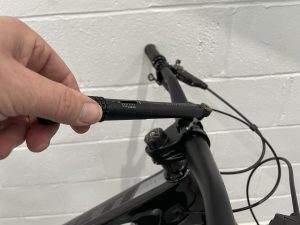Stiff and light
Praxis Works Lyft carbon cranks review
Praxis has done an excellent job on the Praxis Works Lyft crank, it’s stiff, lightweight, top quality and it should stay that way too.
>>> Best mountain bike single ring cranks
Even for a handmade carbon crankset from a USA component maker £499 is a lot of money and it’s even more when you have to find an additional £34.99 for a bottom bracket and £14.99 for the tool to fit it.

Like Race Face, the Lyft crank has a 30mm aluminium spindle, which can run on either a BB30/PF30 or standard BSA bottom bracket. We’ve been testing the latter and it features slightly larger cartridge bearings and cups, which is why you need the dedicated M30 tool to install it.

Fitting the BB and crank is pretty straightforward but you do have to remove a dust cover when running a standard 73mm wide BB.
Bearing adjustment is pretty similar to Race Face with the drive side crank fitting onto the splined spindle and tensioned adjusted via an expanding collar on the opposite side. This collar is aluminium, so feels more precise than the Race Face plastic design but grit can still get underneath causing it to bind.
For some reason there was a bit of creaking in the system; we had the bottom bracket out of the frame four to five times and we still couldn’t get to the bottom of the noise. What was more of worry is there’s no internal plastic sleeve between the bottom bracket cups and every time we removed them, dirt had worked its way inside. In the winter we think this is going to be far worse and it seems a major omission for something that only costs a few pence.
The Lyft is available in 170 and 175mm lengths and with an option on the chain ring size from 28 to 38T. Since Praxis Works has copied SRAM chainring mounting system you can also upgrade to X-Sync 2 Eagle chainring if you prefer.
Chain retention has been flawless with the Praxis Wave ring but it’s not as smooth as SRAM’s X-Sync 2; it’s a little bit grabby as the chain peels off the lower edge.
With its oversized axle the Lfyt is much stiffer than the relative SRAM crank but back-to-back with the Next SL we found it hard to separate both cranks.
Unfortunately the bottom bracket is a weak point and in its current form is unlikely to last a season.
















